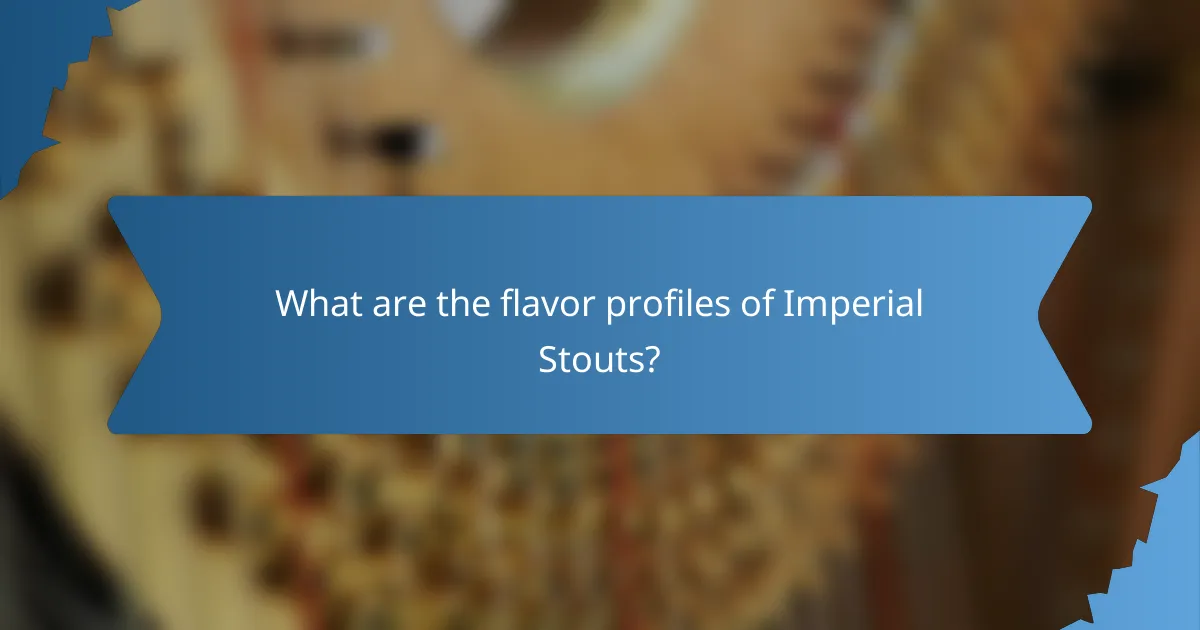Imperial Stouts are celebrated for their rich flavors and high alcohol content, making them a favorite among craft beer enthusiasts. With complex profiles that often feature notes of chocolate, roasted coffee, and dark fruits, these beers offer a robust drinking experience. Pairing them with desserts not only enhances their bold characteristics but also creates a delightful harmony between the beer and sweet treats.

What are the best Imperial Stouts available in Australia?
Australia offers a variety of exceptional Imperial Stouts that are known for their rich flavors and high alcohol content. Some of the best options include Stone & Wood, Coopers, Hawkers, and Little Creatures, each bringing unique characteristics to the table.
Stone & Wood Imperial Stout
Stone & Wood’s Imperial Stout is a robust beer that showcases deep roasted malt flavors complemented by hints of chocolate and coffee. With an alcohol content typically around 8-10%, it delivers a warming sensation that makes it ideal for colder evenings.
This stout is often praised for its smooth mouthfeel and balanced bitterness, making it a great choice for both seasoned stout drinkers and newcomers alike. Pair it with rich desserts like chocolate cake or a creamy cheesecake for an indulgent experience.
Coopers Imperial Stout
Coopers Imperial Stout is renowned for its complex flavor profile, featuring notes of dark fruits, caramel, and a slight smokiness. With an alcohol by volume (ABV) of approximately 7-8%, it strikes a balance between strength and drinkability.
This stout can be enjoyed on its own or paired with desserts such as tiramisu or a dark chocolate tart, enhancing the overall tasting experience. Its rich flavors make it a versatile option for various occasions.
Hawkers Chocolate Imperial Stout
Hawkers Chocolate Imperial Stout is a decadent choice that emphasizes chocolate flavors, making it a favorite among dessert beer lovers. With an ABV of around 8%, it offers a rich and velvety texture that coats the palate.
This stout pairs exceptionally well with desserts like brownies or chocolate mousse, amplifying the chocolate experience. Its sweetness is balanced by a subtle bitterness, making it enjoyable for those who appreciate complex flavors.
Little Creatures Imperial Stout
Little Creatures Imperial Stout is characterized by its bold flavors of roasted malt, coffee, and dark chocolate, with an alcohol content of about 8-9%. This stout is crafted for those who enjoy a full-bodied beer that delivers depth and richness.
It pairs beautifully with desserts such as vanilla ice cream or a spiced apple pie, providing a delightful contrast to the sweetness. The stout’s complexity makes it a great choice for sipping slowly and savoring its intricate flavors.

How to pair Imperial Stout with desserts?
Pairing Imperial Stout with desserts enhances the rich flavors of both the beer and the sweet treats. The high alcohol content and bold profile of Imperial Stout complement various desserts, creating a harmonious tasting experience.
Chocolate cake pairing
Chocolate cake is an excellent match for Imperial Stout due to its deep, rich flavors. The beer’s roasted malt notes amplify the chocolate, creating a decadent experience. Consider a dark chocolate cake with a ganache frosting to enhance the pairing.
When serving, aim for a slice that balances sweetness with the stout’s bitterness. A 60-70% cocoa chocolate cake works well, as it provides enough richness without overwhelming the palate.
Cheesecake pairing
Cheesecake, especially when flavored with chocolate or caramel, pairs beautifully with Imperial Stout. The creamy texture of the cheesecake contrasts with the beer’s carbonation, while the stout’s flavors cut through the richness of the dessert.
Opt for a classic New York-style cheesecake or one infused with espresso or chocolate. A drizzle of chocolate sauce on top can further enhance the pairing, creating a delightful balance of flavors.
Brownies pairing
Brownies, particularly fudgy ones, are a fantastic choice for pairing with Imperial Stout. The dense, chewy texture of brownies complements the stout’s body, while the chocolate flavors resonate with the beer’s roasted notes.
For the best experience, choose brownies made with high-quality chocolate and consider adding nuts or a sprinkle of sea salt to elevate the flavors. Serving them warm with a scoop of vanilla ice cream can create a delightful contrast with the stout.

What are the flavor profiles of Imperial Stouts?
Imperial stouts are known for their complex flavor profiles, which often include rich chocolate, roasted coffee, and dark fruit notes. These flavors contribute to the beer’s overall depth and high alcohol content, making it a popular choice for those seeking a robust drinking experience.
Rich chocolate notes
Rich chocolate notes are a hallmark of imperial stouts, often reminiscent of dark chocolate or cocoa. This flavor is typically achieved through the use of roasted malts, which impart a deep, velvety sweetness that balances the beer’s bitterness.
When tasting an imperial stout, look for variations in chocolate intensity. Some may feature a more pronounced sweetness, while others might lean towards a bitter chocolate profile. Pairing these stouts with desserts like chocolate cake or brownies can enhance the chocolate experience.
Roasted coffee flavors
Roasted coffee flavors are another defining characteristic of imperial stouts, often providing a bold and slightly bitter contrast to the sweetness of the chocolate. This flavor arises from the dark roasting of the malts, which creates a rich, aromatic quality.
Many imperial stouts showcase varying levels of coffee intensity, from subtle hints to strong, espresso-like profiles. For an enjoyable pairing, consider serving these beers alongside desserts like tiramisu or coffee-flavored pastries to complement the coffee notes.
Dark fruit undertones
Dark fruit undertones, such as raisins, figs, or plums, add a layer of complexity to imperial stouts. These flavors can enhance the overall richness and provide a sweet, fruity contrast to the beer’s bitterness.
When exploring imperial stouts, pay attention to how these dark fruit notes interact with the other flavors. Pairing these beers with desserts like fruit tarts or rich cheesecakes can create a delightful balance, highlighting the fruity undertones while enhancing the overall tasting experience.

What is the alcohol content of Imperial Stouts?
Imperial Stouts typically have a high alcohol content, often ranging from around 8% to over 12% ABV (alcohol by volume). This higher alcohol level contributes to their rich, complex flavors and makes them distinct within the stout category.
Average alcohol content range
The average alcohol content of Imperial Stouts usually falls between 8% and 12% ABV, with some exceptional brews reaching even higher levels. This range allows for a robust flavor profile while still being enjoyable for many beer enthusiasts.
When selecting an Imperial Stout, consider that the higher the alcohol content, the more intense the flavors may be. However, balance is key; a well-crafted Imperial Stout should not feel overly boozy despite its strength.
Examples of high-alcohol Imperial Stouts
Some notable examples of high-alcohol Imperial Stouts include Russian River’s Pliny the Younger, which can reach around 10% ABV, and Dogfish Head’s World Wide Stout, which can exceed 18% ABV. These beers are celebrated for their depth and complexity, making them favorites among craft beer aficionados.
When exploring high-alcohol Imperial Stouts, look for limited releases or seasonal brews, as many breweries produce special editions that push the boundaries of alcohol content while maintaining rich flavors.

What are the brewing techniques for Imperial Stouts?
Brewing Imperial Stouts involves specific techniques that enhance their rich flavors and high alcohol content. Key methods include the use of specialty malts and an extended fermentation process, both of which contribute to the beer’s complexity and depth.
Use of specialty malts
Specialty malts are crucial in crafting Imperial Stouts, as they provide the deep, rich flavors characteristic of this style. Brewers often use a combination of roasted malts, chocolate malts, and caramel malts to achieve a balance of sweetness and bitterness.
For example, roasted barley adds coffee and chocolate notes, while caramel malts can enhance the beer’s sweetness and body. The choice and proportion of these malts can significantly influence the final flavor profile, so experimentation is encouraged.
Extended fermentation process
The fermentation process for Imperial Stouts is typically longer than for standard beers, allowing for the development of complex flavors. This extended fermentation can last several weeks to months, depending on the desired characteristics.
During this time, yeast continues to work on the sugars, which can result in higher alcohol content and a smoother finish. It’s essential to monitor the fermentation temperature and gravity to avoid off-flavors and ensure a successful brew.

What are the historical origins of Imperial Stouts?
Imperial stouts originated in the 18th century, primarily as a strong, rich beer brewed for export to Russia. These stouts were crafted to withstand long journeys and appeal to the Russian aristocracy, leading to their distinctive bold flavors and higher alcohol content.
19th-century Russian export
In the 19th century, British brewers began producing imperial stouts specifically for export to Russia, where they gained immense popularity among the elite. The style was characterized by its robust flavor profile, often featuring dark roasted malts, chocolate, and coffee notes, which catered to the tastes of Russian consumers.
The brewing process involved higher alcohol content, typically ranging from 8% to 12% ABV, which helped preserve the beer during transport. This strong beer became a symbol of luxury and indulgence, further solidifying its status in the Russian market.
Connection to British brewing
Imperial stouts are deeply rooted in British brewing traditions, particularly those of London. The style evolved from porters, which were popular in the 18th century, and brewers began to experiment with stronger versions to meet the demands of export markets.
As the style developed, British brewers incorporated various ingredients and techniques, leading to a rich diversity of flavors. Today, many craft breweries in the UK and beyond continue to produce imperial stouts, often using local ingredients to create unique interpretations of this historic beer style.

How do Imperial Stouts compare to other beer styles?
Imperial stouts are known for their rich flavors and higher alcohol content compared to many other beer styles. They typically have a robust profile with notes of chocolate, coffee, and dark fruits, making them distinct from lighter beers.
Comparison with Stouts
While both imperial stouts and regular stouts share a similar base, imperial stouts are generally stronger, often exceeding 8% alcohol by volume (ABV). This higher alcohol content contributes to a fuller body and more intense flavors, setting them apart from their standard counterparts.
Regular stouts usually have a more subdued flavor profile, focusing on roasted malt characteristics. In contrast, imperial stouts can include a wider range of flavors, such as caramel, toffee, and even hints of vanilla or oak, depending on the brewing process.
When choosing between the two, consider the occasion. Imperial stouts are often enjoyed as dessert beers or sipped slowly, while regular stouts can be more versatile for pairing with meals or casual drinking. Keep in mind that the richness of imperial stouts can complement desserts like chocolate cake or rich ice cream.
